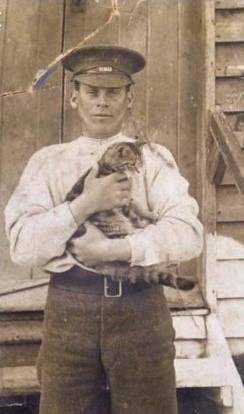AB
Joseph Howson
Information about birth
|
Date of birth: 20/09/1886 |
|
Place of birth: Skelton, Cumberland, England, United Kingdom |
General information
|
Last known residence: 18 Rigg Street, Caldewgate, Carlisle, England, United Kingdom |
|
Profession: Railway Porter |
Army information
|
Country: England, United Kingdom |
|
Force: British Expeditionary Force |
|
Rank: Able Seaman |
|
Service number: R/1379 |
|
Enlistment date: 10/05/1917 |
|
Units: — Nelson Bn. (Last known unit) — 4th Reserve Battalion Blandford |
Information about death
|
Date of death: 01/11/1917 |
|
Place of death: Banff House, Poelcapelle, Belgium |
|
Cause of death: Killed in action (K.I.A.) |
|
Age: 31 |
Memorial
|
Tyne Cot Memorial Panel: 2 |
Distinctions and medals 2
|
British War Medal Medal |
|
Victory Medal Medal |
Points of interest 3
| #1 | Place of birth | ||
| #2 | Last known residence | ||
| #3 | Place of death (approximate) |
My story
Joseph Howson was born on 20 September 1886 in Skelton, Cumberland. He lost his father at a young age. In the 1891 census, his mother was already listed as a widow. He then had two older brothers, Herbert and George. When he was 8 years old, Joseph and his brothers were sent to an orphanage in Banff, Scotland where Herbert and George both died, leaving Jo as the only one of the family. At the age of 24 he turns up again, working as a station porter in Carlisle, Cumberland. He later married Dinah Ann Hodgson, with whom he had four daughters. During the war, on 10 May 1917, he was mobilised and assigned to the 4th Reserve Battalion Blandford, part of the 63rd (Royal Naval Division).
On 31 July 1917, he was assigned to the 5th (Nelson) Battalion of the 2nd Royal Naval Brigade, also known as the 189th Brigade. The Royal Naval Division was on the Flemish front in late October 1917, where it took part in the Second Battle of Passchendaele, part of the Greater Passchendaele Battle. The division's brigades were located southeast of Poelkapelle, between Lekkerboterbeek and Wallemolen. On 26 October 1917, the 188th Brigade was able to capture Varlet Farm and Banff House, while the 189th Brigade was in reserve. The same evening, Banff House was recaptured by German troops. Twice, the 188th Brigade tried unsuccessfully to storm Banff House. A third attack on 31 October, led by the 189th Brigade, was to take the Germans by surprise. Preparatory shelling was abandoned so as not to alarm the German garrison. Under the cover of darkness at 9pm, small groups of the Nelson and Hawke battalions managed to capture the position. German retaliation was not long in coming and the captured positions were heavily shelled on 1 November.
Able Seaman Joseph Howson fell on 1 November 1917 at the age of 31. He has no known grave and is commemorated on panel 2 of the Tyne Cot Memorial. Joseph survived the orphanage in Banff Scotland before being killed at Banff House in Belgium.
On 31 July 1917, he was assigned to the 5th (Nelson) Battalion of the 2nd Royal Naval Brigade, also known as the 189th Brigade. The Royal Naval Division was on the Flemish front in late October 1917, where it took part in the Second Battle of Passchendaele, part of the Greater Passchendaele Battle. The division's brigades were located southeast of Poelkapelle, between Lekkerboterbeek and Wallemolen. On 26 October 1917, the 188th Brigade was able to capture Varlet Farm and Banff House, while the 189th Brigade was in reserve. The same evening, Banff House was recaptured by German troops. Twice, the 188th Brigade tried unsuccessfully to storm Banff House. A third attack on 31 October, led by the 189th Brigade, was to take the Germans by surprise. Preparatory shelling was abandoned so as not to alarm the German garrison. Under the cover of darkness at 9pm, small groups of the Nelson and Hawke battalions managed to capture the position. German retaliation was not long in coming and the captured positions were heavily shelled on 1 November.
Able Seaman Joseph Howson fell on 1 November 1917 at the age of 31. He has no known grave and is commemorated on panel 2 of the Tyne Cot Memorial. Joseph survived the orphanage in Banff Scotland before being killed at Banff House in Belgium.
Sources 7
|
5 Nelson Battalion (The National Archives, KEW (TNA), WO 95/3114/3). https://www.nationalarchives.gov.uk Sources used |
|
Census Returns of England and Wales, 1891 (The National Archives, Kew (TNA), RG12). https://www.nationalarchives.gov.uk/ Sources used |
|
Census Returns of England and Wales, 1911 (The National Archives, Kew (TNA), RG14). https://www.nationalarchives.gov.uk/ Sources used |
|
Douglas Jerrold, The Royal Naval Division, (uckfield, The Naval & Military Press, 1923), 259-261. Sources used |
|
McCarthy Chris., Passchendaele. The Day-by-Day Account (London, Unicorn Publishing Group, 2018), 154 + 158. Sources used |
|
Swales Roy, Nelson at War 1914-1918, a history of Nelson Battalion of the Royal Naval Division (Barnsley SY, Pen & Sword Select, 2004), 174-179. Sources used |
|
UK, World War I Service Medal and Awards Rolls, 1914-1920(The National Archives, Kew (TNA), WO 329). https://www.nationalarchives.gov.uk Sources used |
More information 3
|
Commonwealth War Graves Commission Database https://www.cwgc.org/find-records/find-war-dead/casualty-details/837485 |
|
Lives of the First World War (Imperial War Museum) https://livesofthefirstworldwar.iwm.org.uk/lifestory/6106306 |
|
Namenlijst (In Flanders Fields Museum) https://namenlijst.org/publicsearch/#/person/_id=b00519d7-ed96-4cae-bff1-ad1b72012ff3 |
